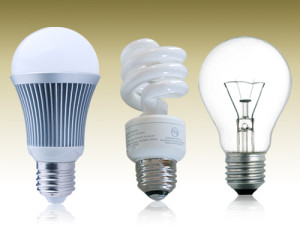Americans in the dark about incandescent light bulb ban
Daily News Article — Posted on January 8, 2014
(by Yannick LeJacq, NBCNews) – The Jan. 1 deadline to end production of 60- and 40-watt incandescent light bulbs just passed, but most Americans aren’t even aware that their traditional light sources will soon become a rare commodity, according to one consumer survey.
 Lighting manufacturer Osram Sylvania recently released its sixth annual “Sylvania Socket Survey,” which found that only 4 in 10 consumers were aware that 60- and 40-watt light bulbs are being phased out in 2014 as production ends.
Lighting manufacturer Osram Sylvania recently released its sixth annual “Sylvania Socket Survey,” which found that only 4 in 10 consumers were aware that 60- and 40-watt light bulbs are being phased out in 2014 as production ends.
Sixty-four percent of participants were aware that a general elimination of incandescent light bulbs was taking place, however, which represents a sharp increase from recent years. In Osram Sylvania’s 2012 survey, only 52 percent of participants were aware of any phase-out. In 2008 – just a year after then-President George W. Bush signed the Energy Independence and Security Act (EISA) into law, mandating that low-efficiency incandescent light bulbs be gradually removed from production – only 21 percent of people surveyed knew of the oncoming shift in how you light up your house.
The government began phasing out 100- and 75-watt light bulbs in 2012 and 2013 respectively. The elimination of 60- and 40-watt bulbs will have a much greater impact on U.S. consumers because they are the two most popular bulbs on the market, according to the electronics industry research firm IMS Research.
Lights out?
With a major shift on the horizon, some Americans are doing their best to take stock of the situation. It’s still perfectly legal to buy incandescent light bulbs as long as supplies last – companies just can’t import or manufacture any new ones. Osram Sylvania’s survey found that 30 percent of those who are aware of the phase-out are planning to stockpile the leftover light bulbs.

From left: LED, CFL and incandescent light bulbs.
Others have already begun to seek out alternatives, however. Noah Horowitz, director of the Center for Energy Efficiency for the liberal environmental group Natural Resource Defense Council, identified “three major types of bulbs to choose from”: more-efficient incandescent bulbs (also referred to as halogen incandescents), LEDs and compact fluorescent (CFLs).
Osram Sylvania’s survey found that 46 percent of respondents are planning to switch to CFLs, while 24 percent prefer LEDs. Thirteen percent hope to use new and improved incandescents.
The 60- and 40-watt light bulbs are being discontinued because they fail to meet standards set forth in EISA. That legislation set a timetable that requires all screw-in light bulbs to use 25 percent less power by 2014 and 65 percent less by 2020, a requirement that is impossible for incandescent bulb manufacturers to accomplish.
You can read the full Osram Sylvania 2013 Socket Survey here.
Reprinted here for educational purposes only. May not be reproduced on other websites without permission from NBC News. Visit the website at nbcnews.com.
Background
from a USA Today report:
Life span of CFLs:
- Some consumers complain that CFLs don't last as long as advertised. One characteristic of CFL bulbs is they are "fairly fragile" and can succumb to overheating, said Terry McGowan, director of engineering for the American Lighting Association.
- "Those life ratings are established in a test lab and not established in somebody's living room fixture," McGowan said. "When you put them in a fixture and bottle them up in a glass shade, they get too hot and the life will be shortened."
- LED lights can also overheat. McGowan recommends using these bulbs in light fixtures that have good ventilation.
- CFL bulbs are also susceptible to shorter life spans when they are frequently turned on and off. A bathroom might not be a good place for a CFL, for example. A table lamp, floor lamp or hallway light would be more likely to extend a CFL bulb's life span, McGowan said.
